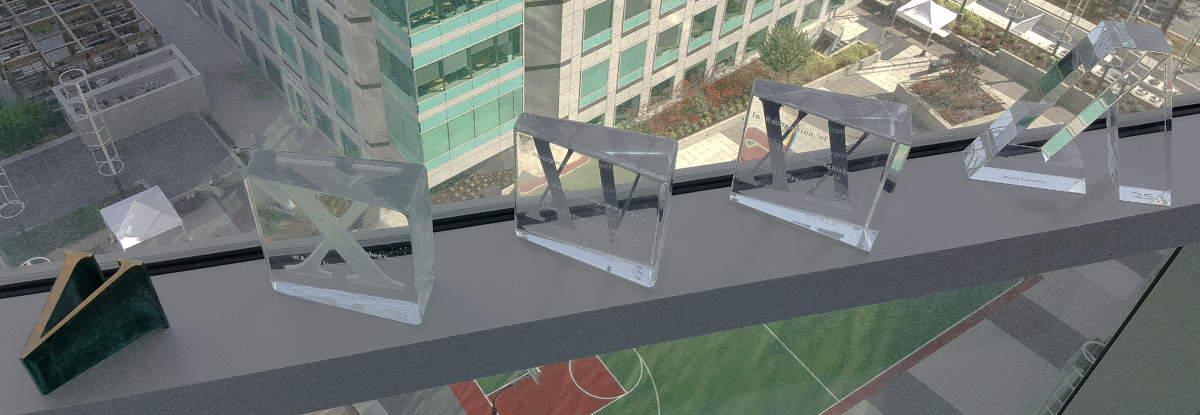Today is Friday, July 1st, 2016, which is a date that has a special significance for me. I am publishing this from Hot Springs, South Dakota where I am enjoying a few days away from work.
My life was put on a new path exactly 25 years ago, on Monday, July 1st, 1991. I was 25 years old at the time, and I am therefore 50 years old now. It was on this date that I started working at Adobe as a member of its Type Development team. My employee number is 879, though at the time there were approximately 500 employees in total. It was a much smaller company back then. As you can see from my very first business card below, I was involved in things related to Japanese type from the very beginning:
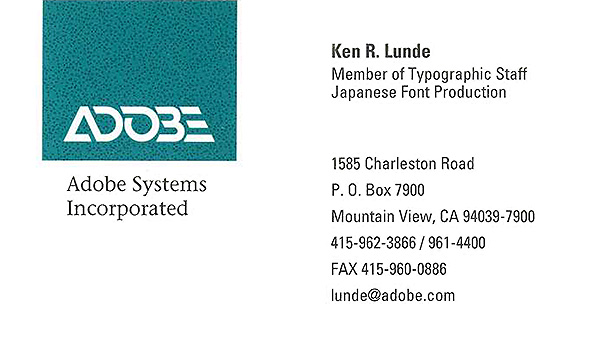
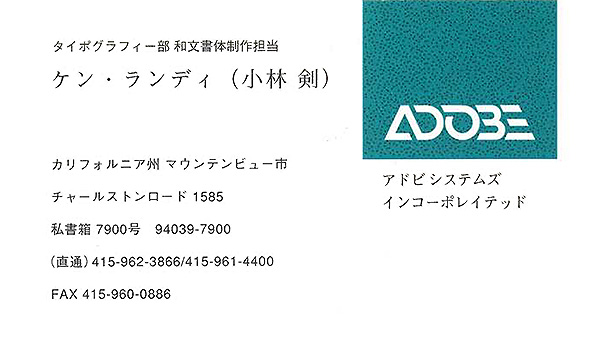
This event effectively launched a 25-year career that is still going strong, and which has been in the same department doing essentially the same thing, though the technologies and related standards have changed or evolved.
The rest of this somewhat lengthy article will be used to highlight some of my accomplishments during each five-year period.
The First 5 Years
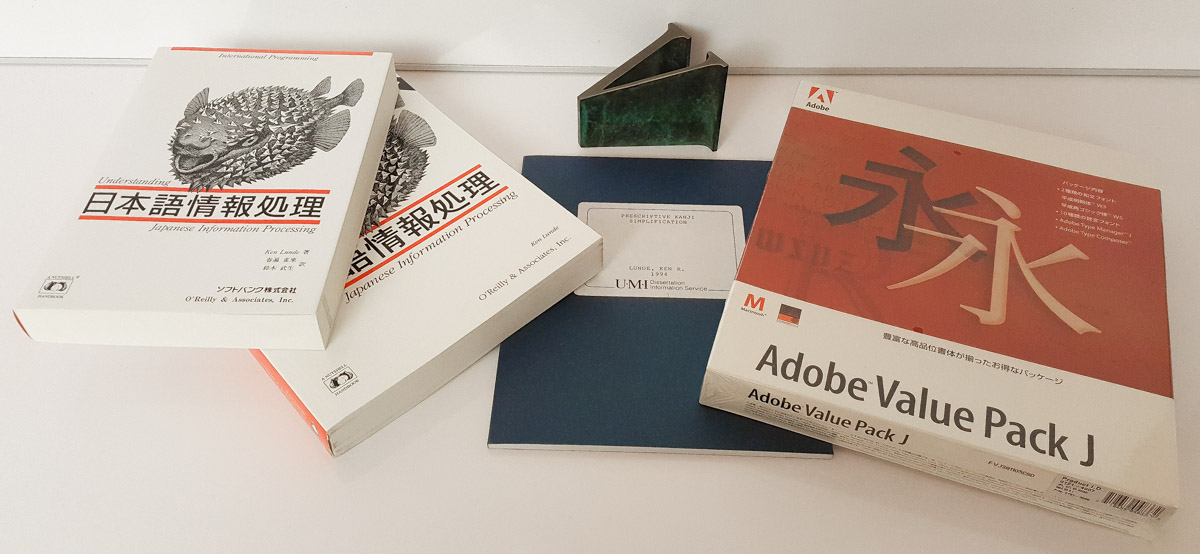
One of my first projects at Adobe was to use a new typeface-design technology that we called Cube to create a small proof-of-concept font based on the Heisei Mincho W3 (平成明朝 W3) typeface design. This technology was so named because it was thought that three design axes could be used for the individual multiple master–like elements that are used as stroke-like components to compose glyphs. I ended up presenting the results to Adobe’s co-founders, John Warnock and Chuck Geschke, in late 1991. This technology—though with additional design axes beyond the initial three—was eventually used to design the glyphs for kanji in the Kozuka Mincho (小塚明朝) and Kozuka Gothic (小塚ゴシック) typeface designs, along with the glyphs for ideographs (aka hànzì, kanji, and hanja) and hangul syllables in the Adobe-branded Source Han Sans (思源黑体 or 思源黑體 or 源ノ角ゴシック or 본고딕) and Google-branded Noto Sans CJK typeface designs.
Other significant projects during this period were the production of the first two Heisei (平成) fonts, Heisei Mincho W3 (平成明朝 W3) and Heisei Kaku Gothic W5 (平成角ゴシック W5), that were released as a package called Adobe ValuePack-J, along with a package called 平成明朝W3 GaijiPack that included the glyphs for JIS X 0212-1990, along with 250 glyphs for JIS C 6226-1978 (aka JIS78) kanji.
Speaking of glyphs, I published Adobe’s first Simplified Chinese, Traditional Chinese, and Korean glyph sets as Adobe-GB1-0, Adobe-CNS1-0, and Adobe-Korea1-0, respectively. Adobe-GB1-1 and Adobe-Korea1-1 were also published during this first five-year period. See Adobe Tech Note #5079 (Adobe-GB1-5), Adobe Tech Note #5080 (Adobe-CNS1-6), and Adobe Tech Note #5093 (Adobe-Korea1-2) for more details.
Two other achievements during this first five years were the writing and typesetting (using Aldus PageMaker Version 4.0J) of my first book, Understanding Japanese Information Processing, which was published in 1993, followed by my PhD (linguistics) dissertation, entitled Prescriptive Kanji Simplification, that I wrote and successfully defended the following year. The Japanese translation of my book, aptly entitled 日本語情報処理 (nihongo jōhō shori), was published by SoftBank in 1995.
Years 6 through 10

One of the first things that took place was the moving of Adobe’s headquarters from Mountain View to downtown San José in early September of 1996.
This second five-year period gave me the opportunity to do the production for Adobe’s very first Adobe Originals typeface families for Japanese, the first one being Kozuka Mincho (小塚明朝), first deployed as sfnt-wrapped CIDFonts in 1997, followed by Kozuka Gothic (小塚ゴシック), first deployed as OpenType/CFF fonts in 2001. It was also during this period that OpenType was born, in April of 1997 to be exact. As an aside, I think that I have the largest collection of printed Kozuka Mincho specimen books.
I also wrote and typeset (using Adobe FrameMaker Version 5.5) my second book, CJKV Information Processing, which was published at the end of 1998.
In the year 2000, I published Adobe’s very first “Pro” Japanese glyph set, Adobe-Japan1-4, in February. The CD in the photo above shows evidence for Adobe-Japan1-4 CID+14106 (劍󠄁; aka Adobe-Japan1 IVS <528D E0101>). Related to CJK glyph sets during this period, I also published Supplements 2 through 4 of Adobe-GB1, Supplements 1 through 3 of Adobe-CNS1, and the still-current Adobe-Korea1-2.
Years 11 through 15
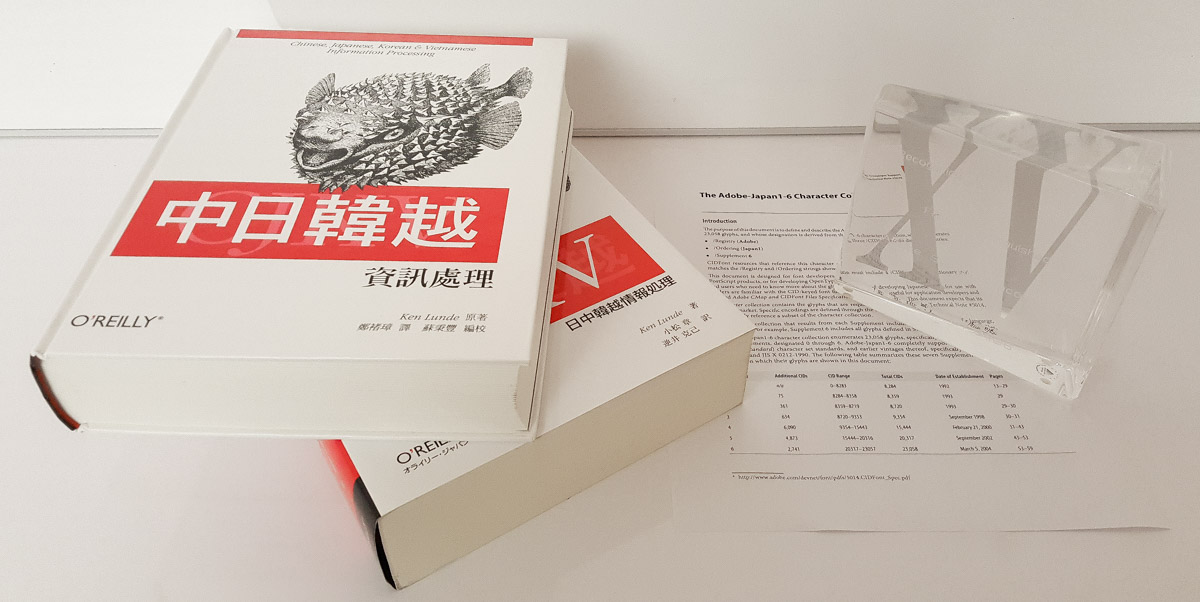
Shortly after the Adobe-Japan1-4 glyph set was released, the JIS X 0213:2000 standard was published. This ultimately led to the development of Adobe-Japan1-5, which was done in cooperation with our friends at Apple, and issued in 2002. Adobe-Japan1-6, whose primary purpose was to incorporate the remaining glyphs for the JIS X 0212-1990 standard, was subsequently issued in 2004. This resulted in the deprecation of the Adobe-Japan2-0 glyph set (see Adobe Technical Note #5097). See Adobe Technical Note #5078 for more information about Adobe-Japan1-6 and earlier Supplements. Also during this period, I published the still-current Adobe-GB1-5, along with Supplements 4 and 5 of Adobe-CNS1.
Oh, and Japanese and (Traditional) Chinese translations of my second book were published in 2002, entitled CJKV 日中韓越情報処理 and 中日韓越資訊處理, respectively.
Years 16 through 20
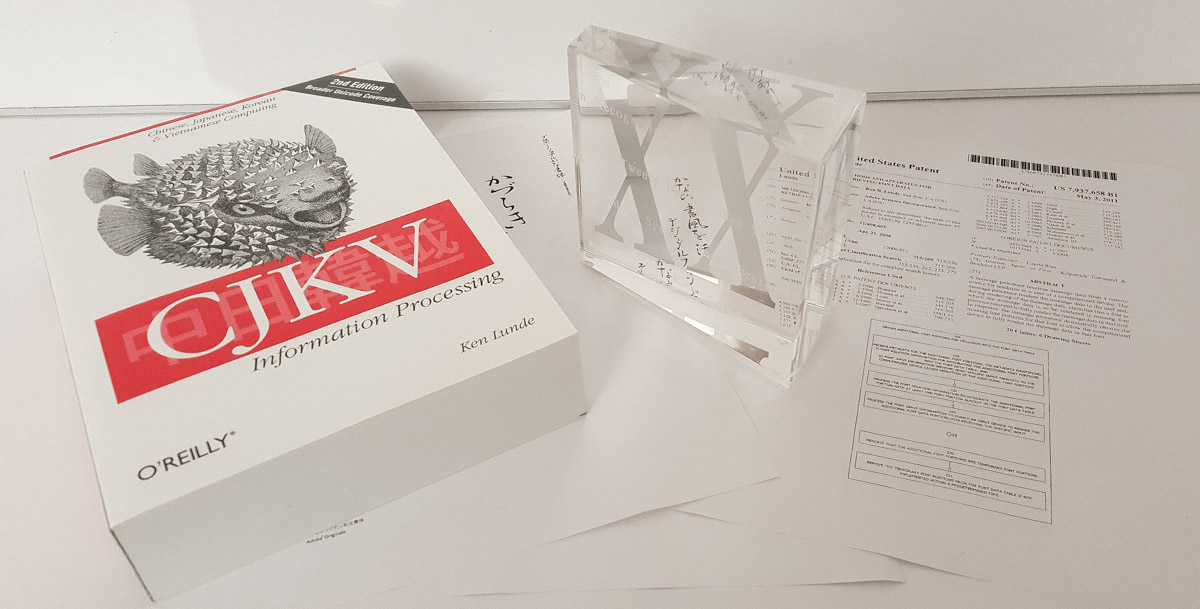
One of the most interesting and challenging typeface designs I helped to develop was Kazuraki (かづらき), whose active development began in 2006, and which was first released in 2009. Its typeface designer is the very talented Ryoko Nishizuka (西塚涼子) in the Tokyo branch of our team. In addition to being the very first fully-proportional Japanese font, it also represents the first broad deployment of the special-purpose Adobe-Identity-0 ROS. To learn more about the Kazuraki development process, please go through my ATypI Hong Kong 2012 presentation.
Related to Japanese and Unicode, my first IVD (Ideographic Variation Database) collection, Adobe-Japan1, was registered at the end of 2007. For those who are unaware, the IVD represents a mechanism for supporting unencoded ideograph (aka kanji) variants in “plain text” using variation sequences. Adobe-Japan1 is the most broadly implemented IVD collection, and is supported by hundreds of OpenType Japanese fonts. I also became the IVD Registrar during this period, meaning that I currently manage all aspects of the IVD. This article from earlier in the year provides some information about the current state of IVD support.
I wrote and typeset (using Adobe InDesign CS3-J) my third book, CJKV Information Processing, Second Edition, which was published at the end of 2008.
I also published the still-current Adobe-CNS1-6 glyph set, designed to accommodate Hong Kong SCS-2008.
My first and only patent, entitled Methods and apparatus for retrieving font data, which was originally filed on April 21st, 2006, was issued on May 3rd, 2011 as US Patent 7937658.
Lastly, I became directly involved in the development of the ISO/IEC 14496-28 standard, entitled Information technology—Coding of audio-visual objects—Part 28: Composite font representation. This standard was first published in 2012, and while it was originally designed to break the 64K-glyph barrier by defining CFR (Composite Font Representation) objects that reference one or more component fonts, it can also be used to define fallback fonts with very rich settings. I managed to successfully argue that this ISO standard be added to the freely-available ones. Be sure to read this article that is one of several CJK Type Blog articles about this standard.
Years 21 through 25
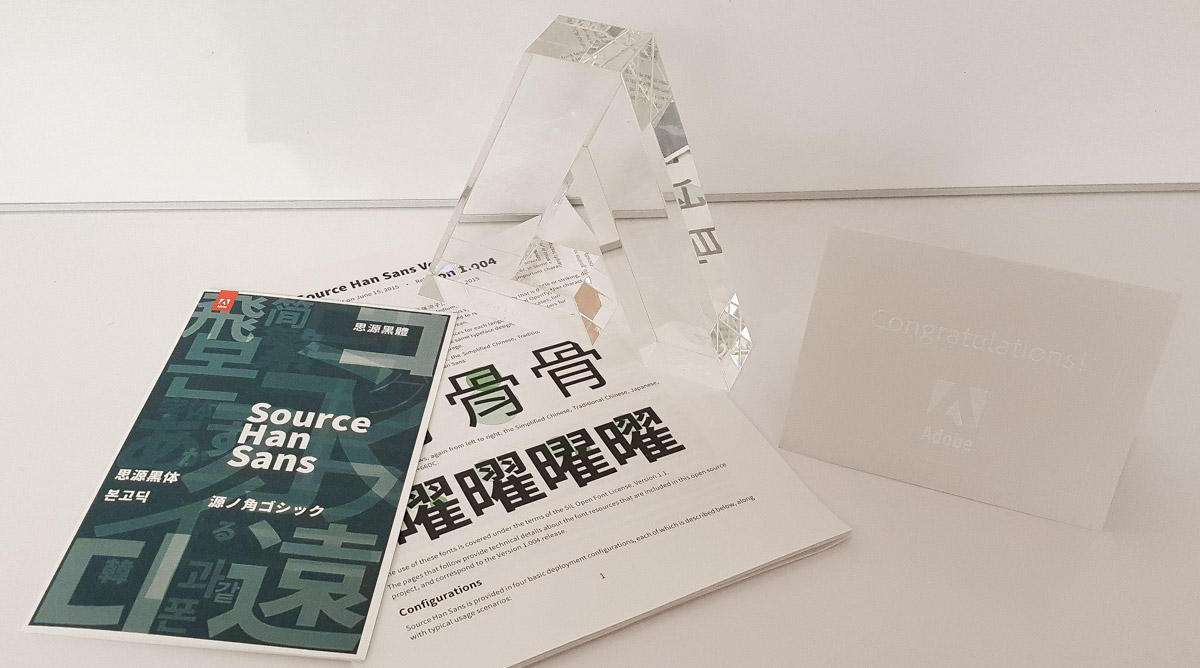
I had the opportunity to attend an ATypI (Association Typographique Internationale) conference for the first time, which was ATypI Hong Kong 2012 that took place in October of 2012. This was also the first time that this annual conference took place in East Asia, so it made sense for me to attend it, and to present, twice. I first presented Kazuraki: Under The Hood, and then presented the first two hours of a three-hour workshop, with my portion being entitled Manipulating CID-Keyed Fonts Using AFDKO Tools. My esteemed colleague, Masataka Hattori (服部正貴), delivered the last hour of the workshop, with his portion being entitled Turning CID-Keyed Fonts Into OpenType Fonts Using AFDKO. I very much enjoyed attending this conference, which gave me an opportunity to meet and speak with key people in the fields of type design and type development.
My biggest accomplishment over the past five years was the planning, development, and deployment of the Adobe-branded Source Han Sans and Google-branded Noto Sans CJK open source Pan-CJK typeface families. This project represents the culmination of an idea that I had way back in 1994, and in many ways represents a dream come true.
Speaking of open source, almost all of my font-related open source projects were released during the past five years. Ignoring Source Han Sans that was mentioned above, the following 16 additional open source projects were prepared and are maintained by me: Adobe Blank, Adobe Blank 2, Adobe NotDef, AGL & AGLFN, AGL Specification, CMap Resources, Command-line Perl Scripts, CSS Orientation Test, FDArray Test, IVS Test, Kenten Generic, LOCL Test, Mapping Resources for PDF, PanCJKV IVD Collection (UNREGISTERED), Tombo SP, and Width Test. Whew!
I also became Adobe’s primary representative to The Unicode Consortium in March of 2015 when Eric Muller left Adobe. I had been serving as Adobe’s alternate representative from January of 2006. I am now attending all four UTC (Unicode Technical Committee) meetings per year.
One of the last things that I will force readers to endure is a look at is my current business card:
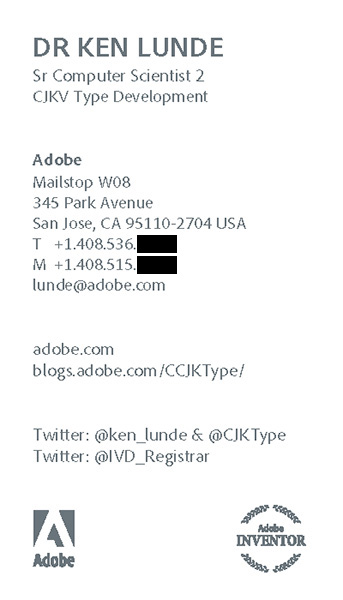
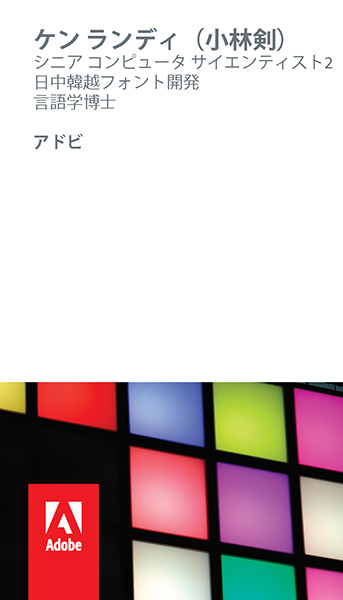
It certainly has been a long and exciting road, and I learned a lot. Naturally, I still have plenty to learn, and I am sure that more challenges lie ahead. I have worked with many highly-talented colleagues, and many of the achievements described above wouldn’t have been possible without their help and encouragement.
In closing, I would like to point out that while reaching this 25-year milestone is clearly an important personal achievement, the average tenure of the current eleven-person Adobe Type Development team (Nicole Miñoza and Steve Ross are still at Adobe, but no longer considered part of this team) is a remarkable 19 years and 10 months. As long as our headcount remains unchanged, we will reach the 20-year milestone in September. In terms of individual tenure, I rank third in the team, behind world-renown typeface designer Robert Slimbach (1987) and David Lemon (1986), who has been my manager for more than half of my tenure.
#AdobeLife

